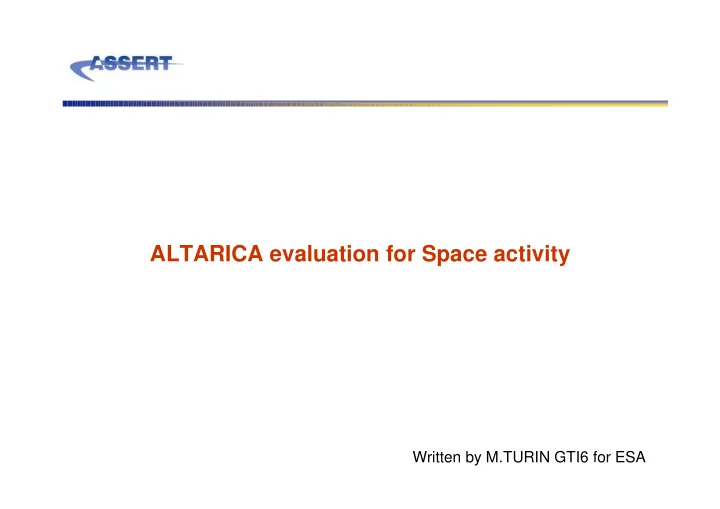

ALTARICA evaluation for Space activity Written by M.TURIN GTI6 for ESA
Space projects problematic Space projects Long mission (spacecrafts), high availability (launchers) Fault tolerance : no single point failure Safety classification : catastrophic for some mission phases Qualification under prime and ESA responsibility : no certification Space technologies: Radiation tolerance to SEU “single event upset” Various mission specific software => reusability difficult Redundancy management and FDIR => complex validation Safety properties to be proven by evidence Overall system engineering & software process will have to be improved => Software crisis
ASSERT study objectives ASSERT will enhance the classical engineering approach by a proof-based method encompassing the full system and software life-cycle supported by a well defined automated process. ASSERT will apply this process on a standardized approach applicable to space activity by identifying system families ASSERT will prove the validity of its new concepts by demonstration on real industrial cases, an intensive education and training program and diffusion of the results within a network of industrial partners (A.NET).
System Engineering Modelling and Verification methods SEMV objectives Independently of functional modelling and abstract architecture SEMV will focus on Safety & reliability requirements formalisation Physical Architecture modelling Verification of safety properties Integrated tools to be defined for both functional and architectural views AADL & UML have been selected for functional modelling OCAS/ALTARICA for dysfunctional modelling SCADE selected for synchronous architecture modelling => bridges shall be found to fulfil the automated process objective
One possible view of ASSERT process (MA3S)
ALTARICA modelling evaluation ATV avionic architecture modelling Done by ONERA with inputs from ASTRIUM 2 views : functional static & architectural But many simplifications : dynamic behaviour not modelled ⇒ Satisfactory results with limits : FMEA list : to be improved for an operational use Failure tree : not usable for dynamic architecture with FDIR, not required by ESA Sequence generation : very attractive (minimal cuts) but tool is slow Reliability estimation : not evaluated but should be interesting (ARALIA…)
ALTARICA modelling remaining questions FDIR modelling SEU modelling : transient failure to be taken into account Interaction with functional modelling : SCADE to ALTARICA translation ? Dynamic architecture with failure propagation from hardware architecture & feedback to functional modes (FDIR, degraded modes) Sequence generation, minimal cut, probability estimation Model checking possibility ? Failure propagation inside software models Software partitioning according to SW category ? Fault containment region, Middleware modelling Reliability modelling Stand-by redundancy & Active redundancy modelling Fault tolerant architecture (TMR) Failure detector performances (alarm rate, undetected error rate) Reliability computation for several years mission FMEA automatic documentation
ASSERT problematic ALTARICA has not the objective to do functional analysis Mapping with organic architecture is mandatory to analyse the failure effects But maintaining several views : functional , organic and RAMS all along the project raises several problems : - How the modelling will be maintained at a good level of detail - How we can do models transformation accurately if the semantic are different
ALTARICA bridge with other tools Translation from/to AADL : limitations ? SMV model checker or any other prover ? SCADE translation ? Other tools (Dassault Aviation)
Recommend
More recommend